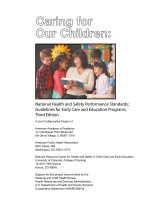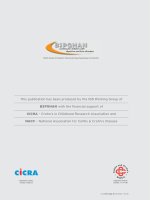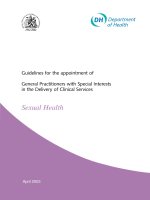Guidelines for Laboratory Practice potx
Bạn đang xem bản rút gọn của tài liệu. Xem và tải ngay bản đầy đủ của tài liệu tại đây (1.07 MB, 81 trang )
!"##$% $&"'&()*+,-,./+&0&123%$"/+&"'&1.+4.5-)$6./&
7.8"3.5"3*&92.#,5*& :++23./-$&(3"%3.;&
<2,= $#,/$+&'"3 &
7.8 "3.5"3*&( 3 5,-$&
General'
Anatomic'Pathology'
Chemistry'
Hematology'
Transfusion'Medicine&
''
2012'Ed ition'
'
Diagnostic Quality Assurance Program
College of Physicians &Surgeons of Saskatchewan
7.8" 3.5"3*&<2,=$#,/$+&>?@>&A=,5,"/&& (.%$&@&
GUIDELI NES'FOR'LABORATORY'PRACTIC E'‐'2012'
SUMMARY'OF'LA BORATORY'GUIDELINES'CHANGES'
'
The'following'GUIDELINES'have'been'revised,'added,'o r'deleted'in'this'edition' of'the'document.'
'
REVISED:'
Per formance'of'Whole'Blood'Gluc ose'Testing'
Urinalysis'
Retent ion'Guideline'
Differential'Performanc e'&'Ref erral'Practice'Guideline'
'
'
ADDED:'
Reference 'Textbook'List '
Indirect'Platelet'Count'
Procedure'for'Platelet'Estimate'
Establishing'Conversion 'Factor'for'PLT'Estimation'
Procedure'for'WBC'Estimate'
Establishing'Conversion 'Factor'for'WBC'E stimati on'
Protocol'for'Validation'of'Linearity'on'Automated'Hematolog y'Analyzers'
'
'
DELETED:'
Diagnostic Quality Assurance Program
College of Physicians &Surgeons of Saskatchewan
7.8" 3.5"3*&<2,=$#,/$+&>?@>&A=,5,"/&& (.%$&>&
Table of Contents
!
General! 4'
' Retention'Guideline'' 5'
' Reference'Textbook'List' 8'
'
Anatomic!Pathology! 10!
' Specimens'Exem pt'from'all'Gross'&/or'Microscopic'Pathology'Labor atories' 11'
' Surgical'Pathology'Reports' 13'
' Remova l'of'Tissu e,'Bl ocks'or'Slides'from'the'Original'Hospital'Site' 14'
' Perf ormance'of'Non‐Gynecological'Cytology' 16'
' Follow‐up'Reports'for'Gynecological'Cytology' 17'
' Follow‐up'Program'for'Cytology' 18'
'
Chemistry! 19!
' Estimated'Glomerular'Filtration'Rate'–'eGFR' 20'
' Cholesterol/ Triglyceride/Lipid'Testing' 21'
' Urinalysis' 22'
' Rep orting'Sperm'in'Urine' 22'
' Quality'Control' 23'
' Perf ormance'of'Whole'Blood' Gluc ose'Testi ng' 24'
' Diagnosis'and'M onitoring'of'Thyroid'Disease' 26'
' Presence'of'Small'Amounts'of'Albumin' 29'
' Crosscheck/Validation'Guideline'for'T hose'Facilities'with'Multiple'C hemistry'Instruments' 30'
' Procedure/Method'Statis tical'Work‐up/Va lidation'Study'Guidelines' 31'
'
Hematology! 33!
' Prin ciples'for'Hematology'Practice' 34'
' Hematology'Films/Labelling'of'Slides' 35'
' Morphology'of'Lymp hocytes' 36'
' Differen tial'Performance'and'Referral'Practice'Guideline' 38'
' Red 'Blood'Cell'Morpholo gy'Repor ting'Guideline' 40'
' Differen tial'Quality'C ontrol' 42'
' Smudge 'Cells' 45'
' Flow'Cytometry'for'the'Diagnosis'of'Lymphoma/Leukemia' 46'
' Mal aria' 47'
' Erythrocyte'Sedimentation'Rate'(ESR)' 48'
' D‐dimer ' 49'
' 3.2%'Na 'Citrate'Anticoagulant'Rec ommended'vs.'3. 8%'for'Coagulation'St udies' 53'
' Vitamin'B12'&'Folate' 54'
' Bleeding'Time' 56'
' Semen/Sper m'Analysis' 57'
' Crosscheck'Valid ation'Gu ideli ne'for'Facilities'with'Multiple' Hematology'Instruments' 58'
' Procedure/Method'Statis tical'Work‐up/Va lidation'Study'Guidelines' 59'
' Protocol'for' Validation'of'Linearity'on'Automated'Hematology'Analyzers '' 61'
' Procedure'for'WBC'Estimate' 64'
' '
Diagnostic Quality Assurance Program
College of Physicians &Surgeons of Saskatchewan
7.8" 3.5"3*&<2,=$#,/$+&>?@>&A=,5,"/&& (.%$&B&
'
'
' Establishing'Con version'Factor'for'WB C'Estimation' 66'
' Procedure'for'Platele t'Estimat es' 68'
' Establishing' Conversion'F acto r'for'PLT'Estimation' 70'
' Indi rect' Platelet'Count' 72'
' '
'
Transfusion!Medicine! 74!
' Retention'of'Transfusion'Medicine'Re cord s' 75'
' Procedure/Method'Statistical'Vali dation/Work ‐up'Guidelines'–'Trans.'Med.' 76'
!
Diagnostic Quality Assurance Program
College of Physicians &Surgeons of Saskatchewan
7.8" 3.5"3*&<2,=$#,/$+&>?@>&A=,5,"/&& (.%$&C&
GENERAL
Diagnostic Quality Assurance Program
College of Physicians &Surgeons of Saskatchewan
7.8" 3.5"3*&<2,=$#,/$+&>?@>&A=,5,"/&& (.%$&D&
RETENTION GUIDELINE
Laboratories vary in size, facility and extent of services provided. Clinical laboratories must
maintain thorough, accessible records that can demonstrate an acceptable standard of care and
compliance with the accreditation requirements.
The Laboratory Quality Assurance Program of the College of Physicians and Surgeons urges
laboratories to retain records, materials, or both for a longer period of time than specified for
educational and quality improvement needs.
Laboratories must establish policies that meet or exceed the following minimum requirements
for retention of documents and specimens as established by professional and/or regulatory
organizations.
References include: CSTM, CSCC, CAP, CSA, ISO, CPSS
Diagnostic Quality Assurance Program
College of Physicians &Surgeons of Saskatchewan
7.8" 3.5"3*&<2,=$#,/$+&>?@>&A=,5,"/&& (.%$&E&
Record Retention
Storage Time
Hematology
Biochemistry
Microbiology
Cyto-
pathology
Surgical
Pathology
Accession record
1 year
1 year
1 year
2 years
2 years
Worksheets
1 year
1 year
1 year
6 months
6 months
Instrument print-outs
1 year
1 year
1 year
n/a
n/a
Paper copy of patient reports
3 months
3 months
3 months
indefinite
indefinite
Quality control/PT documents
2 years
2 years
2 years
2 years
2 years
Maintenance records
2 years
2 years
2 years
Life of the instrument,
plus 2 years
Service records
Life of the instrument, plus 2 years
Method /instrument evaluation
2 years after the method has been discontinued
Procedure Manual
2 years after procedure has been discontinued
Technologist ID & initials
log/computer
1 year
1 year
1 year
1 year
1 year
Telephone logs
3 months
3 months
3 months
3 months
3 months
Requisition
3 months
3 months
1 year
5 years
5 years
Laboratory Information Systems
Records
- Validation records, including
transmission of results and
calculations
- Database changes
- Hardware and software
modifications
- LIS downtime and corrective
action
2 years
2 years
2 years
2 years
2 years
Biomedical Waste
Manifests must be retained for a minimum of 1 year
Diagnostic Quality Assurance Program
College of Physicians &Surgeons of Saskatchewan
7.8" 3.5"3*&<2,=$#,/$+&>?@>&A=,5,"/&& (.%$&F&
Specimen Retention
Hematology
Chemistry
Microbiology
Cytopathology
Surgical
Pathology
Peripheral Blood
Smear
-7days
Peripheral
Blood Smear
reviewed by a
pathologist
-1 yr
Semen smears
- 3 months
Bone Marrow
Slides/Reports
- 20 yrs (adults)
- 50 yrs
(children)
Whole
blood/Plasma
- 24 hrs after
report has been
finalized
Body fluids
- 48 hrs after
report has been
finalized
Urine
- 24 hrs after
report has been
finalized
Whole blood,
serum &
plasma
- 48 hrs after
report has been
finalized
Body fluids
- 48 hrs after
report has been
finalized
Urine - routine
- 24 hrs after
report has been
finalized
24hr Urines
- samples
discarded 48
hrs after report
has been
finalized
Swabs or
specimens
- 24 hrs after
report has been
finalized
Positive Blood
Culture
- 5 days after
reporting
Gram Stain
- one week or
until final report
is sent
Ova & Parasite
slides
- one month
Slides
neg/unsatisfactory
- 5 years
Slides
suspicious/pos
- 20 years
Fine-needle
aspiration slides
- 20 years
Cytology
Consultation/
Requisition
- Indefinitely
Male fertility
slides
- 1 year
Cytology
paraffin blocks
- 20 years
Blocks & slides
- 20 yrs (adults)
- 50 yrs (children)
Autopsy
- 20 yrs
Gross specimen
- min. 8 weeks
after issue of
report
Wet Autopsy
Tissue
- 8 weeks after
issue of report
Bone Marrow
Slides/ Reports
- 20 yrs (adults)
- 50 yrs (children)
Photographic
Transparencies –
indexed and kept
indefinitely
Diagnostic Quality Assurance Program
College of Physicians &Surgeons of Saskatchewan
7.8" 3.5"3*&<2,=$#,/$+&>?@>&A=,5,"/& (.%$&G&
&
REFERENCE TEXTBOOK LIST
Microbiology
1) Manual of Clinical Microbiology 10
th
Edition; American Society for Microbiology; Murray,
Patrick R.
2) Bailey & Scott's Diagnostic Microbiology 12
th
Edition, Mosby, Inc.; Forbes, Betty A., et al.
3) Clinical Microbiology Procedures Handbook 3
rd
Edition; Issenburg
Transfusion Medicine
1) Circular of Information, Canadian Blood Services (most recent version)
2) Canadian Standards Association Blood and Blood Component Z902 (most recent version)
3) Canadian Society for Transfusion Medicine (most recent version)
4) Modern Blood Banking and Transfusion Practices 5
th
Edition; Harmening, Denise M.
5) Canadian Medical Association Journal Guidelines for Red Blood Cell and Plasma
Transfusion for Adults and Children; supplement to CAN MED ASSOC J 1997;
156 (11)
6) American Association of Blood Banks Technical Manual - most recent edition
7) Bloody Easy 3: Blood Transfusions, Blood Alternatives and Transfusion Reactions 3
rd
Edition; Ontario Regional Blood Coordinating Network
Hematology
1) Color Atlas of Hematology, Hematology and Clinical Microscopy Resource Committee,
CAP; Glassy, Eric F.
2) Clinical Hematology: principles, procedures, correlations 2
nd
edition; Stiene-Martin,
Lotspeich-Steininger, Koepke
3) Hematology: Clinical Principles and Applications 3
rd
Edition; Rodak, Fritsma, Doig
4) Clinical Hematology Atlas 3
rd
Edition; Carr/Rodak
Chemistry
1) Tietz Fundamentals of Clinical Chemistry 6
th
Edition, W. B. Saunders Company; Burtis,
Ashwood, Bruns
Diagnostic Quality Assurance Program
College of Physicians &Surgeons of Saskatchewan
7.8" 3.5"3*&<2,=$#,/$+&>?@>&A=,5,"/& (.%$&H&
&
2) Clinical Chemistry – Principles, Procedures, Correlations 6
th
Edition; Bishop
Urinalysis
1) Graff’s Textbook of Urinalysis and Body Fluids 2
nd
Edition; Mundt, Shanahan
Anatomic Pathology
1) Histotechnology: A Self Instructional Text 3
rd
Edition; Carson & Hladik
2) Principles of Anatomy & Physiology 13
th
Edition; Tortora & Grabowski
Safety
1) Transportation of Dangerous Goods Act and Regulations
Supplement Canada Gazette, Part II [www.tc.gc.ca/eng/tdg/clear-tofc-211.htm]
2) CSMLS Guidelines – Laboratory Safety, 6
th
Edition
Competency Evaluation
1) Canadian Society of Medical Laboratory Science
PO Box 2830 LCD 1
Hamilton, ON L8N 3N8
website www.csmls.org
Certification - Competency Profiles
Diagnostic Quality Assurance Program
College of Physicians &Surgeons of Saskatchewan
7.8" 3.5"3*&<2,=$#,/$+&>?@>&A=,5,"/& (.%$&@?&
&
ANATOMIC
PATHOLOGY
Diagnostic Quality Assurance Program
College of Physicians &Surgeons of Saskatchewan
7.8" 3.5"3*&<2,=$#,/$+&>?@>&A=,5,"/& (.%$&@@&
&
SPECIMENS EXEMPT FROM ALL GROSS &/OR MICROSCOPIC
PATHOLOGY LABORATORIES
Irrespective of the exemptions listed below, gross &/or microscopic examinations will be
performed whenever the attending physician requests it, or at the discretion of the pathologist
when indicated by gross findings.
SPECIMEN TYPE
DISCRETIONARY
GROSS &/OR
MICROSCOPIC
Abdominal pannus
Accessory Digits
Amputation
Bone or cartilage removed from the arthritic
joints during joint replacement surgery
Bone segments removed as part of corrective
orthopedic procedures (for example: rotator
cuff, synostosis repair, spinal fusion)
Bunions and hammer toes
Calculi (renal bladder etc.), are sent for
chemical analysis and description
(By Chemistry Dept.)
Disc Materials
Extraocular muscle from corrective surgical
procedures (strabismus repair)
Femoral head removed for prosthesis (if
straight forward)
Foreign bodies, such as bullets or
medicoloegal evidence that is given directly
to law enforcement personnel
Gangrenous and traumatized limbs
Intrauterine contraceptive devices without
attached soft tissue
Loose bodies (joint)
Medical devices such as catheters,
gastrostomy tubes, myringotomy tubes,
stents and sutures that have not contributed
to patient illness, injury or death
Middle ear ossicles
Nasal bone and cartilage from rhinoplasty or
septoplasty
Orthopedic hardware and other radioopaque
mechanical devices provided there is an
alternative policy for documentation
Diagnostic Quality Assurance Program
College of Physicians &Surgeons of Saskatchewan
7.8" 3.5"3*&<2,=$#,/$+&>?@>&A=,5,"/& (.%$&@>&
&
SPECIMEN TYPE
DISCRETIONARY
GROSS &/OR
MICROSCOPIC
Placentas which do not meet the criteria for
examination
Prosthetic breast implants
Prosthetic cardiac without attached tissue
Rib segments or other tissue removed only
for the purpose of gaining surgical access
from patients who do no have a history of
malignancy
Saphenous vein segments harvested for
coronary artery bypass
Skin or other normal tissue removed during
cosmetic or reconstructive procedures
(blepharoplasty, cleft palate repair,
abdominoplasty, rhinectomy or syndactyly
repair) that is not contiguous with a lesion
and that is taken from a patient who does not
have a history of malignancy
Teeth without attached soft tissue
Therapeutic radioactive sources
Tonsils and adenoids if clinically not
suspicious
(under 10 yrs
old)
(over 10 yrs)
Torn menicus
Varicose veins
Diagnostic Quality Assurance Program
College of Physicians &Surgeons of Saskatchewan
7.8" 3.5"3*&<2,=$#,/$+&>?@>&A=,5,"/& (.%$&@B&
&
SURGICAL PATHOLOGY REPORTS
Timeliness of reports is critical to providing quality of care. Guidelines for surgical pathology
reporting include:
(i) Routine Surgical Pathology reports
Complete within 2 working days.
Where additional procedures are being performed, an extension of 24
hours is appropriate.
(ii) Autopsy Reports
Written initial reports of gross pathological findings within 72 hours.
Final Report – 30 days for routine cases, 90 days for complicated cases
Diagnostic Quality Assurance Program
College of Physicians &Surgeons of Saskatchewan
7.8" 3.5"3*&<2,=$#,/$+&>?@>&A=,5,"/& (.%$&@C&
&
REMOVAL OF TISSUE, BLOCKS OR SLIDES FROM THE ORIGINAL HOSPITAL SITE
Anatomic Pathologists are charged with the responsibility of keeping and guarding the integrity
of the ever-growing number of tissue containing paraffin blocks and slides derived from surgical,
cytological and autopsy diagnostic services. Documentation and maintenance (tracking) of the
continuous care shall ensure quality practice. These specimens must be maintained in orderly
files to ensure ready access. There are inevitably increasing demands for slides, blocks or tissues
to be retrieved from the original site.
*A release form must be provided and retained on file at the original institution for permanent
release.
Summary
Follow HIPA guidelines
Ensure there is sufficient material for further work-up
Indicate reason for request
Return all material as soon as possible
The lab is the custodian of tissue, blocks or slides collected.
The source of material remains the property of the patient.
These are the various suggested categories to be considered:
In-Province Consultation
• Request may be initiated by the primary physician, surgeon or oncologist for review by local
or out-of-district pathologist.
• Request may be initiated by the original signing out pathologist who is responsible for
maintaining records and assuring return of the material.
Note: The return of materials to the original site must be documented and a consult report sent
to the original pathologist as well as the requesting pathologist.
Out-of-Province (recommended slides only)
• Request from an originating pathologist to seek out-of-province consultation for diagnostic
purpose.
• Research or national study groups request specimen be referred to another institution for
treatment.
• If blocks are requested, cut a set and send the cut set. The originals should be maintained at
the processing site.
Educational Consultation
• Requests for educational rounds should be restricted to slides; to ensure integrity of patient
property.
• Request should indicate “for rounds” and materials returned promptly to ensure ongoing
patient care.
Diagnostic Quality Assurance Program
College of Physicians &Surgeons of Saskatchewan
7.8" 3.5"3*&<2,=$#,/$+&>?@>&A=,5,"/& (.%$&@D&
&
Research
• Regulations require pathologists to obtain patient authorization and/or an Institutional
Review Board (Ethics Committee) waiver of informed consent when using any identifiable
patient health information for research purposes.
• Requests must ensure the integrity of the patient material.
• All materials that have critical diagnostic, prognostic or medical-legal implication may be
retained at the discretion of the releasing institution.
• Return all materials as soon as possible.
References:
Guardians of the Wax…and the Patient. Editorial.; American Journal of Clinical Pathology 1995 104 p 356-7
Use of Human Tissue Blocks for research. Association of Directors of Anatomic and Surgical Pathology. Human Pathology
1996.27 p 519-520
Diagnostic Quality Assurance Program
College of Physicians &Surgeons of Saskatchewan
7.8" 3.5"3*&<2,=$#,/$+&>?@>&A=,5,"/& (.%$&@E&
&
PERFORMANCE OF NON-GYNECOLOGICAL CYTOLOGY
Non-gynecological cytology comprises of fine needle aspiration biopsies (FNAB) of
organs/tissues such as lungs and other visceral lesions, effusion cytology of pleural, peritoneal,
pericardial fluids, cytology of urine, CSF, sputum, broncho-alveolar lavage (BAL) and brush
biopsies of endoscopic procedures, (gastrointestinal tract, etc). Scrapings of open lesions and
nipple discharges may also be included along with cytology of transplant organs to test for
rejection (kidneys), or for cyclosporin toxicity. BAL and transplant cytology is usually done in
specialized centers as it requires specific interpretation and often special tests. Most of the other
samples can be handled and processed in a routine surgical pathology/cytology lab equipped
with basic facilities including a biological safety cabinet (fume hood), cyto-centrifuge and
staining capability for H & E and PAP stains.
In contrast to gynecological cytology, non-gynecological cytology (NGC) does not necessarily
require a screening step. If adequate diagnostic material is present the focus is on diagnosis of
and interpretive correlation with the clinical setting. If cell block or cytospin samples are
available, further testing with special procedures could be performed.
Some aspects of NGC require a rapid turnaround time such as FNAB performed under CT-scan
or ultrasound guidance and intra-operative cytology requests.
It is important for institutions with CT scanner facilities to be able to provide cytology service in
house. However, it is acceptable, if the lab does not have a cytology department, the
technologists in the histology lab are trained in processing the specimens. Such training is easily
obtained and can be provided by short courses provided on site and documented.
Most NGC procedures are performed on patients who are in-patient residents in a hospital/health
care institution or are required to come in for a day procedure/ambulatory care. Due to the time
factor involved in patients’ institution stay; a rapid turnaround time becomes a key factor in
availability of the service. On the other hand, the patient in an acute care setting may have an
infectious process or malignancy requiring rapid diagnosis and treatment.
The final interpretation and reporting of non-gynecological cytology shall be made by a
pathologist.
Diagnostic Quality Assurance Program
College of Physicians &Surgeons of Saskatchewan
7.8" 3.5"3*&<2,=$#,/$+&>?@>&A=,5,"/& (.%$&@F&
&
FOLLOW-UP REPORTS FOR GYNECOLOGICAL CYTOLOGY
To ensure a quality cytology service, a follow-up mechanism must be in place to provide reports
to the primary and/or consulting physician.
In an attempt to eliminate the potential for “LOST – TO FOLLOW” reporting situations, the
following require follow-up letters to the primary and/or consulting physician:
1. A repeat smear was requested at the time of reporting and 3 months have lapsed since the
date of request.
2. A diagnosis is rendered requiring follow-up and none has occurred. For example:
HSIL required follow-up a.s.a.p. and if this has not occurred within 3 months, a letter
is required.
LSIL (ASCUS, AGUS) within 6 months requires a letter in 9 months.
A malignant diagnosis with no apparent followup.
3. A follow-up letter has been previously issued with no reply. These letters should be
automatically generated by the computer system and then replies must be recorded and
reviewed quarterly.
4. A minimum laboratory requirement of a computer system used to report gynecological
cytology shall have the ability to generate automatic follow-up letters that are linked to
diagnostic codes.
Diagnostic Quality Assurance Program
College of Physicians &Surgeons of Saskatchewan
7.8" 3.5"3*&<2,=$#,/$+&>?@>&A=,5,"/& (.%$&@G&
&
FOLLOW-UP PROGRAM FOR CYTOLOGY
A follow-up mechanism shall be in place to ensure that actions appropriate for abnormal findings
are implemented.
a) All patients who are reported to have a significant abnormality should be followed up by
the laboratory or other agency to which this task may be delegated, to obtain final clinical
or preferably tissue confirmation of the diagnosis.
b) Statistical data should be maintained which would include the number of cases screened
annually in each category, and all correlative follow-up data available. Discrepancies, if
any, should be included with this information.
Diagnostic Quality Assurance Program
College of Physicians &Surgeons of Saskatchewan
7.8" 3.5"3*&<2,=$#,/$+&>?@>&A=,5,"/& (.%$&@H&
&
CHEMISTRY
Diagnostic Quality Assurance Program
College of Physicians &Surgeons of Saskatchewan
7.8" 3.5"3*&<2,=$#,/$+&>?@>&A=,5,"/& (.%$&>?&
&
ESTIMATED GLOMERULAR FILTRATION RATE - eGFR
Evidence-based clinical practice guidelines suggest that an estimate of GFR (eGFR) provides the
best clinical tool to gauge kidney function. The Canadian Society of Nephrology has
recommended that laboratories report eGFR routinely for adult patients, in order to detect
chronic kidney disease.
Serum creatinine results can vary significantly and tend to be ineffective in general practice as an
early marker. 24 hr. collection for creatinine clearance is impractical and prone to error. eGFR
should be reported on outpatients over the age of 18 years. eGFR has not been validated for use
in hospitalized patients and therefore, is not recommended for reporting on inpatients.
eGFR is less reliable in,
• patients with near normal eGFR
• unstable serum creantinine
• acute illness
• extremes of body composition (eg. obesity, cachexia)
• unusual muscle mass (eg. marked muscularity, muscle disease, amputation)
• pregnancy
• age under 18 years or over 70 years
• drugs with significant renal toxicity or clearance
• drugs affecting creatinine metabolism or clearance
• unusual dietary intake (eg. vegetarians)
• other serious comorbid conditions
Summary:
Reporting of eGFR is becoming the standard of care in helping identify, stage and monitor
patients with chronic kidney disease.
eGFR > 60
Normal or slightly decreased kidney function
(stages 1 or 2)
eGFR 30-59
Moderately decreased kidney function (stage 3)
eGFR 15-29
Seriously decreased kidney function (stage 4)
eGFR < 15
Kidney failure (stage 5)
• eGFR is frequently used for DRUG DOSING using the Cockroft-Gault equation. eGFR-MDRD has not been
validated for this purpose.
• eGFR-MDRD assumes “steady state”. For rapidly changing kidney function, monitor serum creatinine.
(MDRD: Modification of Diet in Renal Disease)
• The reported eGFR shall be multiplied by 1.21 for patients of African descent.
NOTE: This information is intended for clinicians, patients and allied health professionals.
References: www.jasn.org, www.csnscn.ca, www.kidney.org, www.renal.org
Diagnostic Quality Assurance Program
College of Physicians &Surgeons of Saskatchewan
7.8" 3.5"3*&<2,=$#,/$+&>?@>&A=,5,"/& (.%$&>@&
&
CHOLESTEROL / TRIGLYCERIDE / LIPID TESTING
Cholesterol results are based on optimal performance of testing. Considerations to be included:
a) treatment/preparation of the patient
b) the emergent or non-emergent nature of the test
c) appropriate technical equipment
d) adequate quality control
The accomplishment of treatment goals also demands accurate cholesterol measurements. This
requires standardization of all cholesterol measurement for accuracy to minimize the method-
specific biases. This can be achieved ONLY by standardizing the cholesterol measurements and
ensuring accuracy that is traceable to the National Reference System for Cholesterol
(NRS/CHOL), National Cholesterol Education Program.
Clinical protocols are well established and should be followed by all testing sites.
Laboratories testing for lipids shall be capable of performing the entire profile, to include:
Cholesterol, Triglycerides, HDL and LDL, for diagnosis and assessment. All lipid
measurements should be performed by the same methodology.
Only instrumentation capable of maintaining intralaboratory precision that is less than or equal to
3 % (C.V.); and can demonstrate an accuracy bias of less than 3 % from the true value may be
used for cholesterol analysis.
Diagnostic Quality Assurance Program
College of Physicians &Surgeons of Saskatchewan
7.8" 3.5"3*&<2,=$#,/$+&>?@>&A=,5,"/& (.%$&>>&
&
URINALYSIS
Complete urinalysis shall include microscopic examination if the following are present:
leukocyte esterase, blood, protein, turbidity and nitrites.
The microscopic examination should be completed within four hours of collection. (Note:
specimens not tested within 2 hours should be refrigerated.)
Report quantitative results in SI units.
REPORTING SPERM IN URINE
Sperm are not normally present in urine and if presence is detected, it is usually considered a
contaminant.
When sperm appear in a microscopic exam, they shall be reported as present. However, prior to
reporting, results should be discussed with the attending physician, in order to avoid errors (ie.
mislabelling, etc.).
Diagnostic Quality Assurance Program
College of Physicians &Surgeons of Saskatchewan
7.8" 3.5"3*&<2,=$#,/$+&>?@>&A=,5,"/& (.%$&>B&
&
QUALITY CONTROL (QC)
The purpose of QC is to detect the problems early enough to prevent their consequences.
QC emphasizes statistical control procedures, but may also include non-statistical check
procedures, such as linearity checks, reagent and calibration checks, etc.
Two or three different materials should be selected to provide concentrations that monitor
performance at different levels of medical decision-making.
For quantitative tests, the use of two levels of control material shall be run each day of use, as a
minimum.
For qualitative tests that include built-in controls, a positive and negative control shall be
performed a minimum of once per month and upon initiation of a new lot number and shipment.
For those that do not include a built-in control, known positive and negative external controls
shall be tested each day of use.
Diagnostic Quality Assurance Program
College of Physicians &Surgeons of Saskatchewan
7.8" 3.5"3*&<2,=$#,/$+&>?@>&A=,5,"/& (.%$&>C&
&
PERFORMANCE OF WHOLE BLOOD GLUCOSE TESTING
Glucose meters are a convenient, quick and simple means for clinicians and their patients to
obtain a blood glucose estimation. Glucose meters are not designed to diagnose diabetes and
should not be used to monitor seriously ill patients. The results from a properly used glucose
meter are accurate enough to determine insulin dosage and dietary compliance. Glucose meters
allow for frequent and rapid blood glucose estimations thereby improving the overall control of
the diabetic state. Glucose meter testing is intended to supplement rather than substitute for
clinical laboratory testing.
The basic requirements for whole blood glucose testing shall include proper training to ensure
consistent operating techniques and a quality control surveillance program to ensure proficiency.
The Clinical and Laboratory Standards Institute (CLSI) serves as the reference for this document.
All glucose meter testing, performed outside the traditional laboratory, excluding patients
performing glucose in his place of residence is required to meet the criteria of quality assurance
to ensure acceptable performance. The glucose meter is appropriate for monitoring treatment,
but not suitable for diagnostic testing (i.e. GTT) The components of glucose monitoring by
glucose meters will include, but not restricted to the following:
1. Choosing the meter
Personnel at sites where glucose testing is performed by glucose meter will consider the
following components when determining which meter to use:
evaluations by pathologist-supervised laboratories to include:
analytical proficiency,
user satisfaction,
cost,
ease of use.
review proficiency testing results to assess performance on that meter
review the number of users for that instrument
technical limitations of the meter to include:
hi/lo range,
technical service support
It is recommended that only one type of testing meter be used in a program. This is because of
potentially confusing differences among the various systems for testing and quality control
procedures.
CAUTION: very high hematocrits in newborns interfere with results, so specific instruments
shall be recommended for glucose estimations in newborns.
2. Internal QC
Daily controls ensure accurate performance of the meter. This may include:
- running controls once per day of use for each machine; alternating high and low
levels









